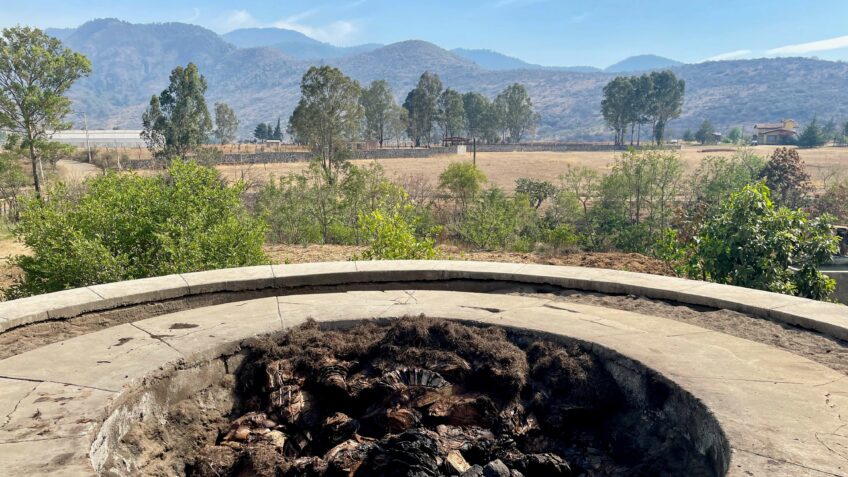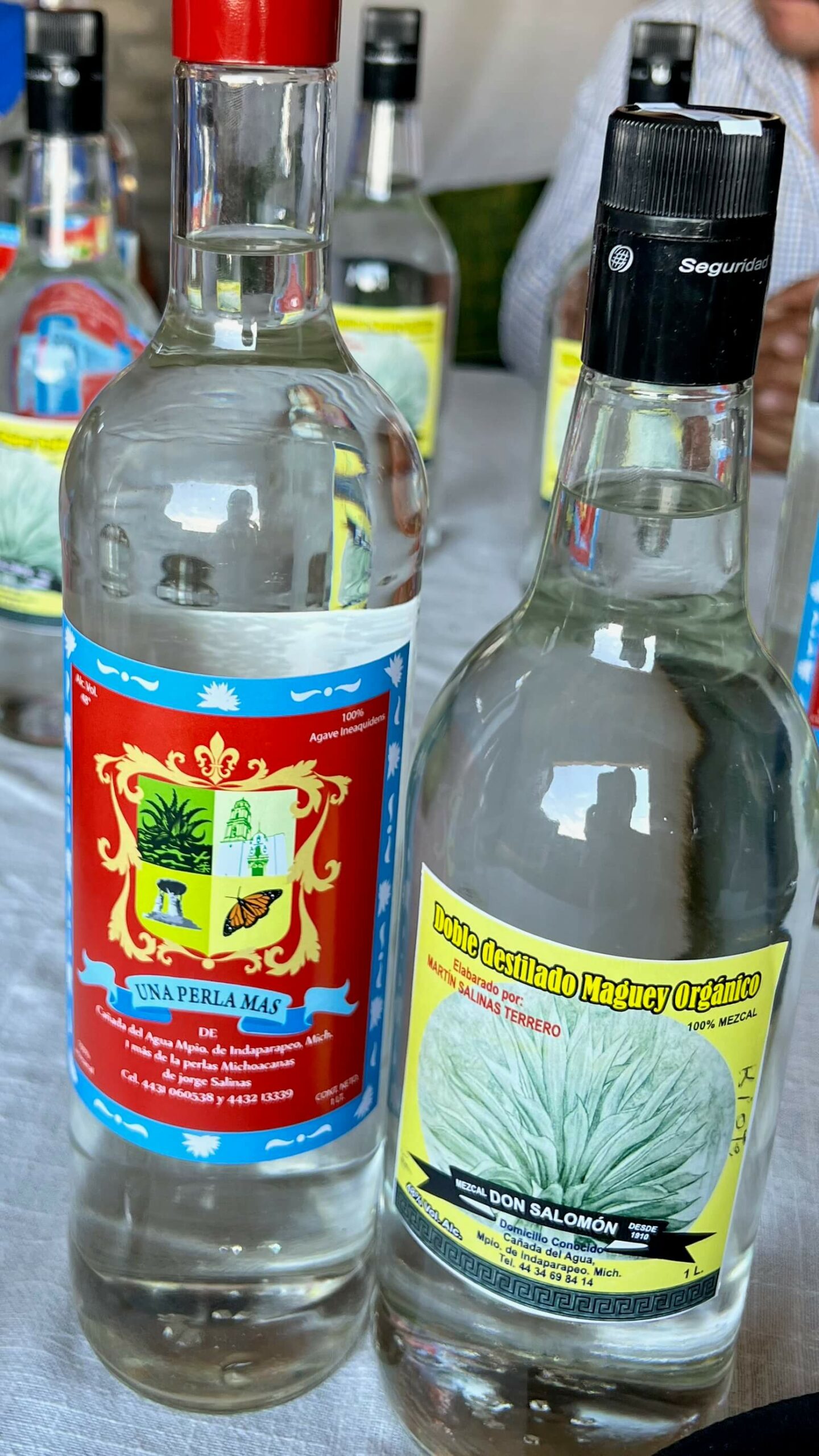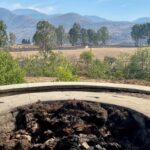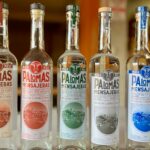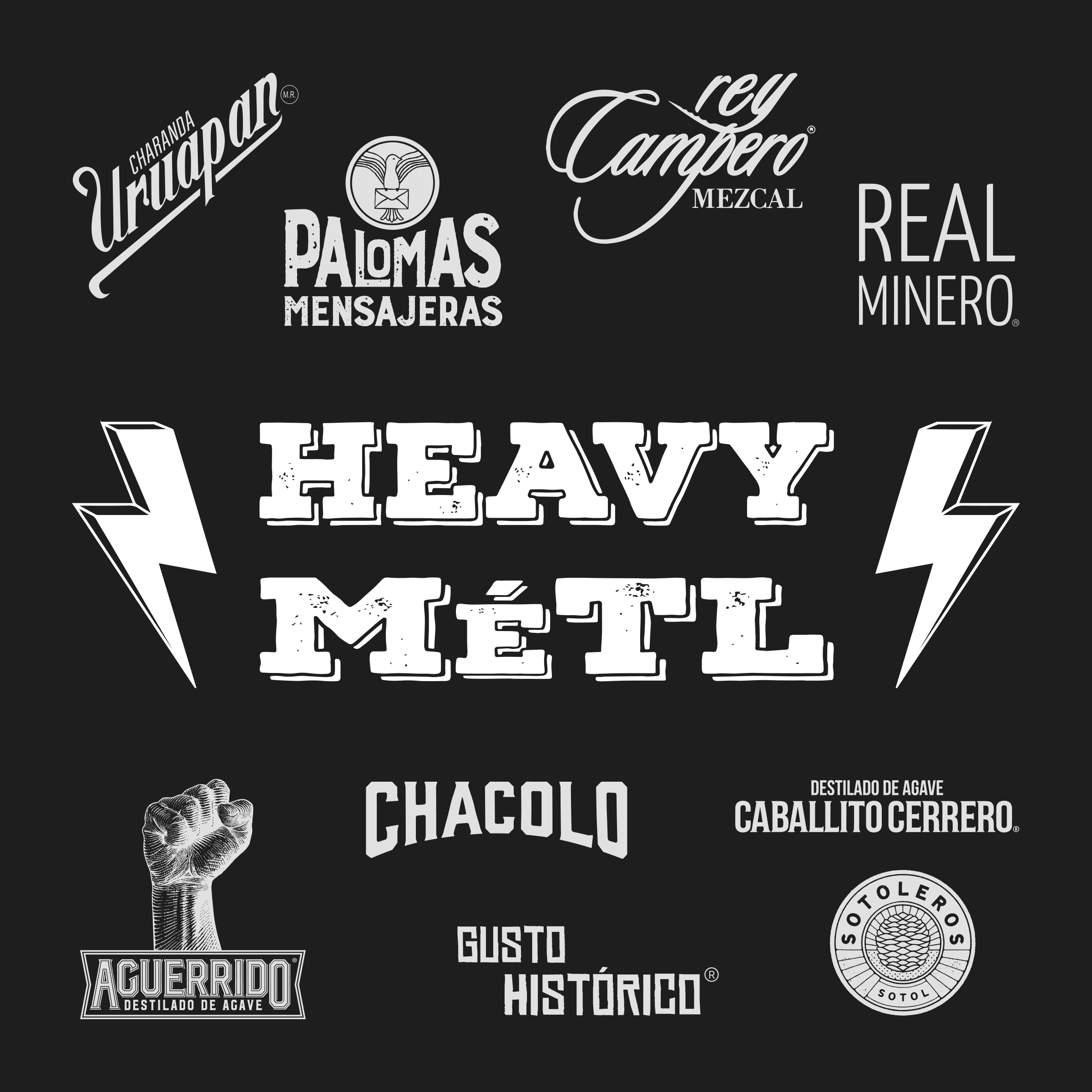Río de Parras, Michoacán is a small community of around 600 residents. It is about an hour drive northeast of Morelia, the state capital. Río de Parras landed on our radar after we tried mezcal from Jorge Perez. Bottled under the labels Mezonte and Siembra Metl, Jorge produces amazing destilado de agave using Maguey Alto (Agave inaequidens) with pulque added in the fermentation. Then Mal Bien Alto, also from Río de Parras, hit the market in 2019 and became a favorite amongst mezcal fans. So when we planned our first trip to Michoacán, a trip to Rio de Parras was high on our wishlist.
How would we get out there? That’s where Alva Magaña comes in. We always try to book a day with a local guide whenever we visit a new mezcal destination in Mexico. Alva had an Airbnb Experience listing: Dive into the world of mezcal, tasting and tour. Some pictures were uploaded on her tour listing. The photos were of the vinata (distillery – called ‘palenque’ in Oaxaca) of Emilio Vieyra of Mezcal Don Mateo. We had already talked to Emilio about visiting him on our last day of the trip so connecting with Alva was fortuitous. Things were coming together nicely. We arranged for a full day tour with Alva to Rio de Parras. We wanted to visit the Perez family and Isidro Rodriguez and she could plan the rest of the day.
On the day of the tour, we hit the road with Alva and started learning about all the things she was working on. Like us, Alva had been interested in mezcal for many years. Originally from Michoacàn, she worked in Mexico City and then in Oaxaca with a brand from Sola de Vega. Upon returning to Michoacán, she wanted to work with the most famous producer in her home state. She wanted to promote the mezcal of Michoacán. Alva reached out to Emilio. It turned out that he needed help coordinating the mezcal certification process for Don Mateo. On top of working with Don Mateo, she began running mezcal tours and opened Salón Tsïtsïki, a mezcaleria in Morelia.
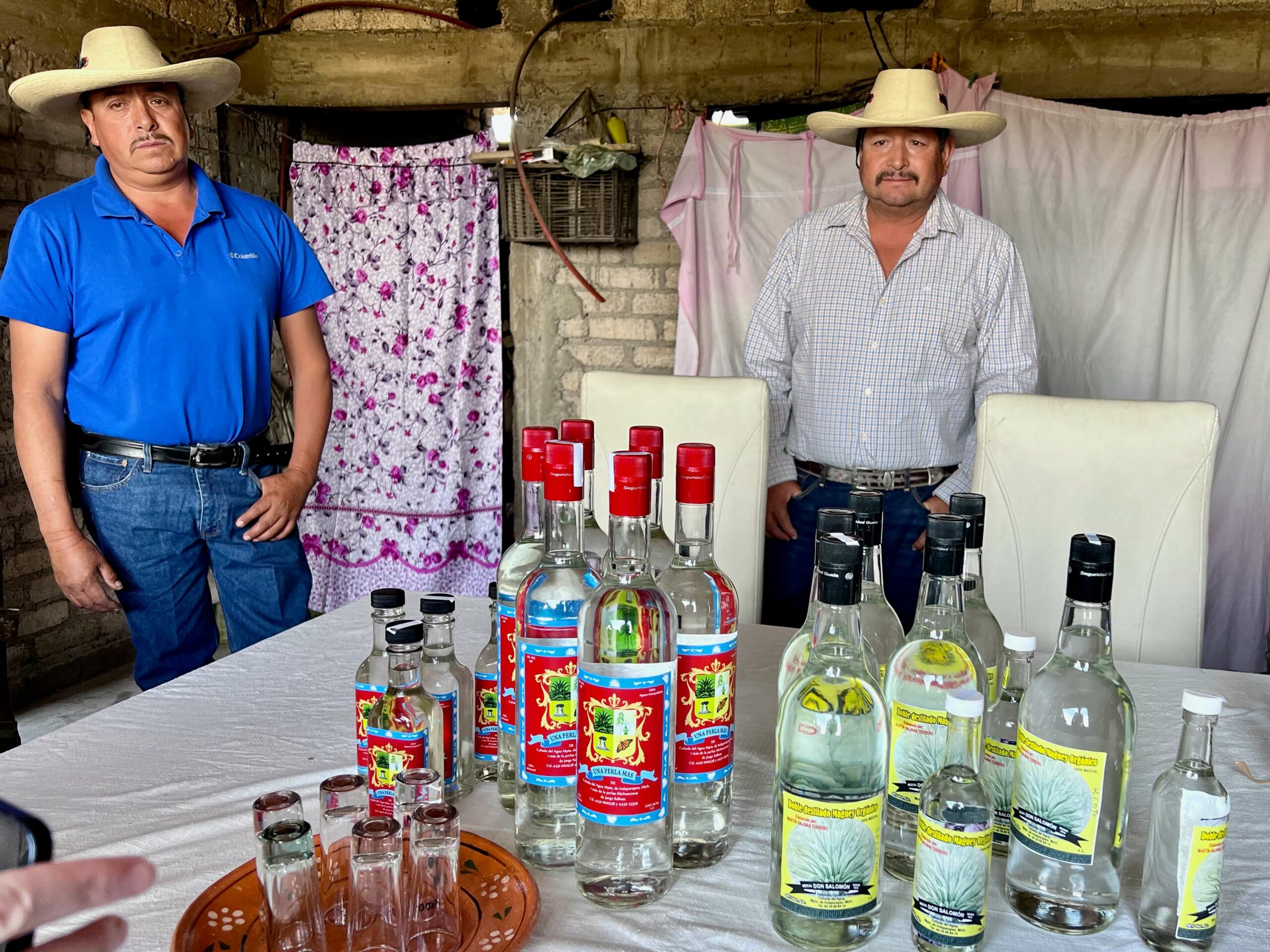
Jorge and Martín stand behind their respective agave spirit creations
The Salinas brothers
Our first stop was to visit brothers Jorge and Martín Salinas. We’d seen a few of their mezcals on social media but knew nothing about them except they produced in Rio de Parras. This is why we were confused as we drove into a familiar place: Cañada del Agua. “They live here, we are going to their house,” Alva explained. We pulled to the side of the road and parked. Up the road was the home of Miguel Ortiz Villagomez, a mezcalero we visited a few days prior.
The hot sun beat down on us as we stepped out of the van. We walked down a short path from the main road. Brothers Jorge and Martín, wearing large cowboy hats, greeted us. Both looked tired but offered smiles. We soon learned their brother had tragically passed away very recently. Our visit suddenly felt like an imposition but they assured us they were eager to share mezcal. “Let’s get out of the sun,” they said, pointing towards the house. Alva, myself, and two other gringo mezcalheads sat across from the brothers. Sunlight and a light breeze came in through the open windows. We could see the sadness in their eyes. It’s a cliche but mezcal was the perfect ice-breaker for this situation.
Para todo mal, Mezcal; para todo bien también
In their grief, the brothers abstained from mezcal that day, but the phrase was still fitting. Jorge stood up and grabbed a bottle of his Alto and Chino ensamble mezcal. He poured it slowly for our group. We took small sips in the quiet, cool room. The aromas of pulque were immediately noticeable. Sipping revealed more nuanced agave flavors. It was good and we smiled.
We began asking questions to fill the silence. Martin and Jorge are fifth-generation mezcaleros who produce small batches when they have time. Their primary jobs are selling cattle for meat. They produce mezcal at a community vinata in Rio de Parras, which was nearby. They told us the cooler water in Rio de Parras improves the fermentation process.
The brothers take pride in their traditional methods. They use wild agaves from an ejido and other areas. The cooked agaves are milled by hand with axes and mallets. They start fermentation with at least 20 liters of pulque. We learned that the pulque needs the correct balance of sweetness or it can change the final product. Since pulque itself is continually fermenting, timing is important.
Their father, Don Salomon, passed down his recipe for making adjustments. He is the patriarch of the family and the namesake of Martin’s mezcal brand. Carefully blending the head, hearts, and tails is a crucial final step in their process. Their mezcal often ends up being 50%-51% alcohol by volume but the community prefers 48%.
Next, Martín poured one of his mezcals from a bottle labeled Don Solomon. As we sipped, Martin’s piercing gaze studied our faces, seeking our honest reaction to his mezcal. Once again, we smiled and nodded at one another. Their solemn expression began to relax a bit. They told us that they saw us a few days prior when we were with the other mezcalero Miguel. A couple gringos was a rare sighting in their village. Everyone laughed.
Drinking quiote
After trying some single agave and two agave ensamble mezcals, the brothers shared their 100% quiote mezcals. These special batches were small due to low yield of quiotes. The flowering stalk, or quiote, appears once in the lifetime of an agave plant. It shoots up from the middle of an agave, using all the energy from the plant core, to grow seeds and reproduce. The quiotes are usually harvested before the stalk grows branches. The “castrated” agave is then left to grow for another year or so before being harvested. Some of these releases are labeled as “capon” mezcals.
Distilling the quiote itself is rare in our experience, yet somewhat common in Michoacán. Besides distilling quiote, their mother sometimes boils pieces of quiote to eat with chile negro. The quiote has some unique properties different from an agave piña. Fermentating 100% quiote batches is colder. The side of the fermentation vat feels like sticking your hand in the fridge, according to Martín. This is unlike agave fermentation when the vat exterior is warm. We sipped distilled Alto quiote that day which was a different flavor profile than mezcal. The brothers told us that their family keeps the Cupreata quiote batches for themselves.
By the end of the tasting, the mood had become more jovial. The mezcal helped, and it seemed our visit was a brief respite from their profound grief. We bought a few bottles and thanked them for their generous hospitality. As we parted ways, Martin and Jorge left us with a humble insight: “Some producers say they know everything, but they can’t know everything.” We kept that thought in mind as we continued our day visiting mezcaleros in Rio de Parras.
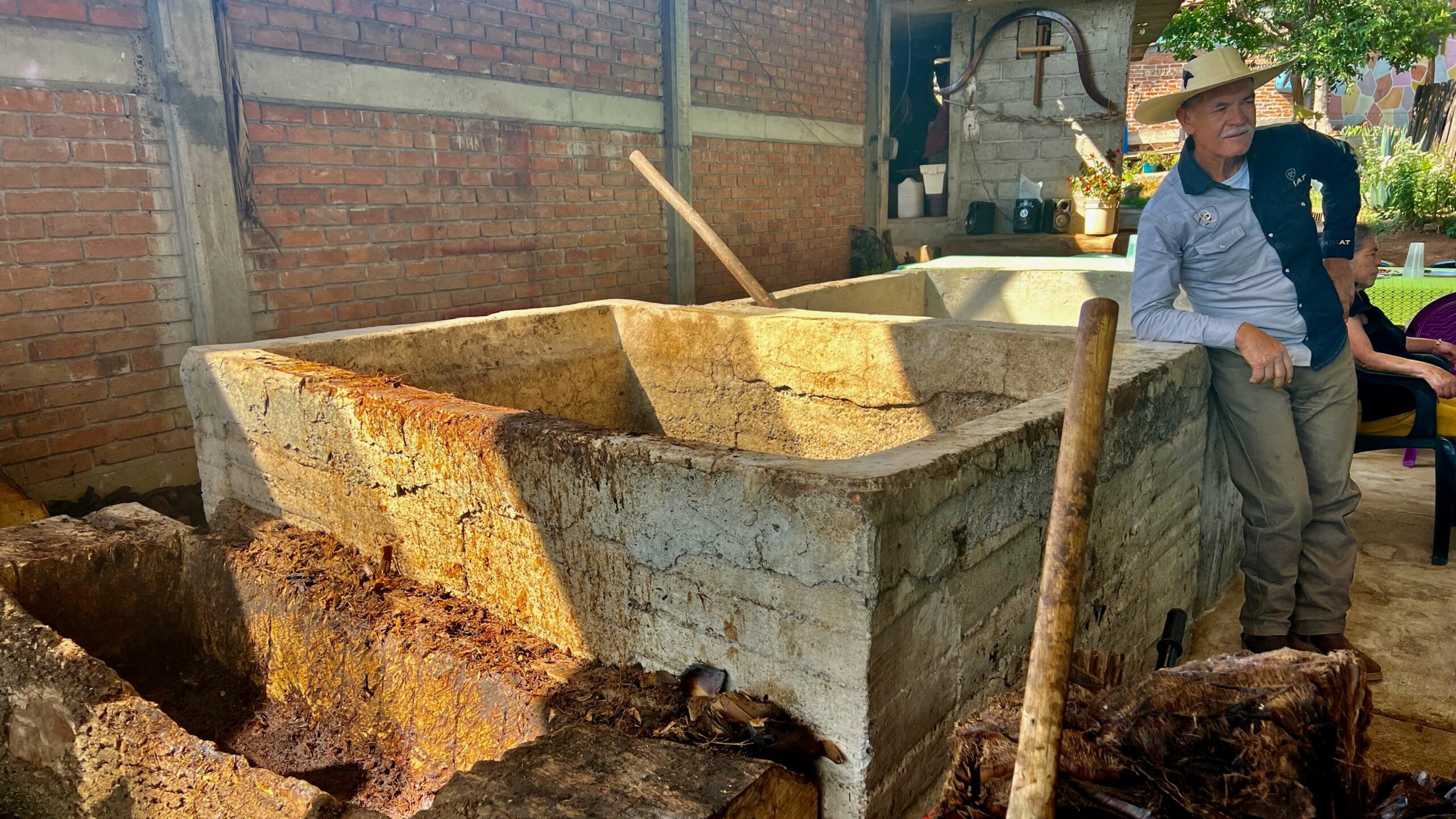
Jorge Perez leans against the large cement fermentation containers
The mezcal teacher
As the van left Cañada del Agua, we thanked Alva for coordinating the visit with the Salinas brothers. Now it was time to visit the legendary Jorge Perez. After a short drive, we arrived at the Perez home and vinata. Miguel Perez, Jorge’s son, greeted us upon arrival. His excited energy was a stark contrast to our previous stop. He led us past the house and into the vinata area. We met the rest of the family, including Jorge, who stood back and observed our group. Miguel showed us around as we took photos.
Jorge used to work in the silver and magnesium mines. His father, Miguel’s grandfather, was also a miner. Jorge rented vinatas for 30 years, paying a fee of 15-20 liters each time. Later, he established his own vinata named Salto Bonito. The smell of cooked agave filled Salto Bonito as we explored. Here, the father-son team did about 6 ovens worth of mezcal per year. Each oven would result in about 400 liters of mezcal which is less than 3,000 liters per year. Agaves cook for about 3 weeks which means that dry fermentation begins after the heat subsides. Next, fermentation in 7-8 ton cement tanks lasts for about 12 days with spring water and pulque added. The 18-year-old stills are a traditional Filipino stills often seen in Michacán. Even the wood planks of the still top were 12 years old.
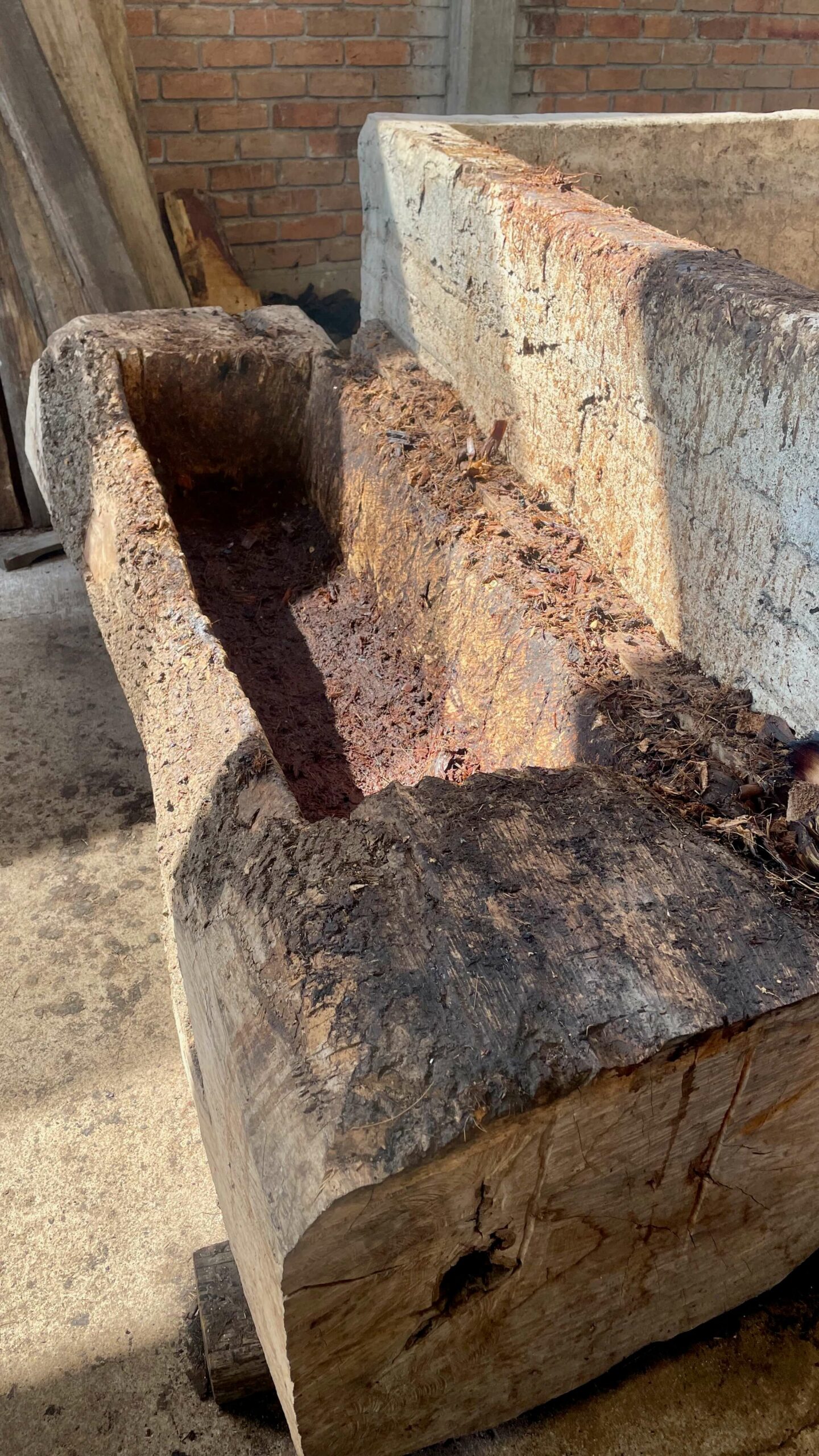
A hollowed out tree trunk used for mashing cooked agave
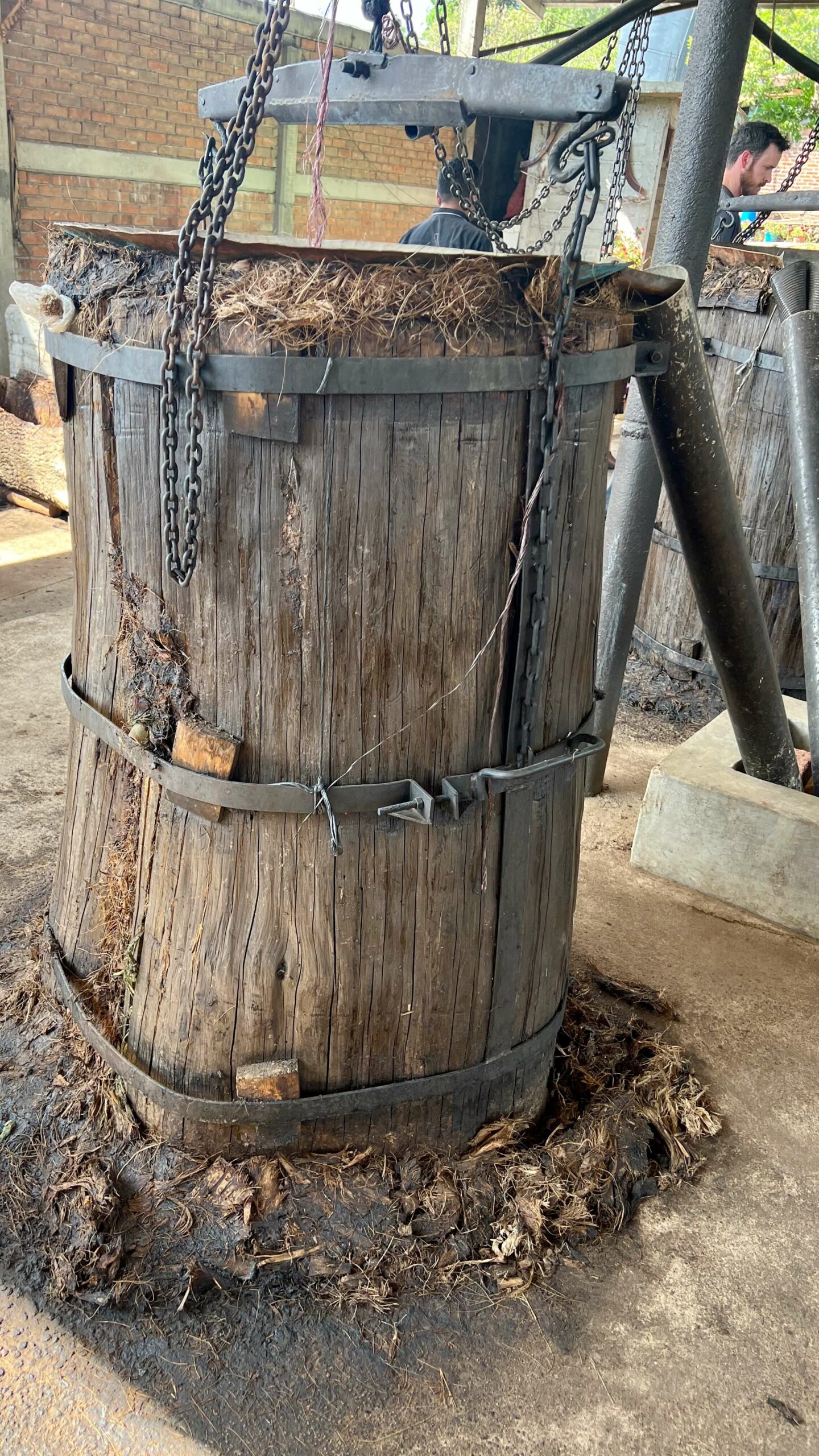
One of the Filipino stills with the wooden top
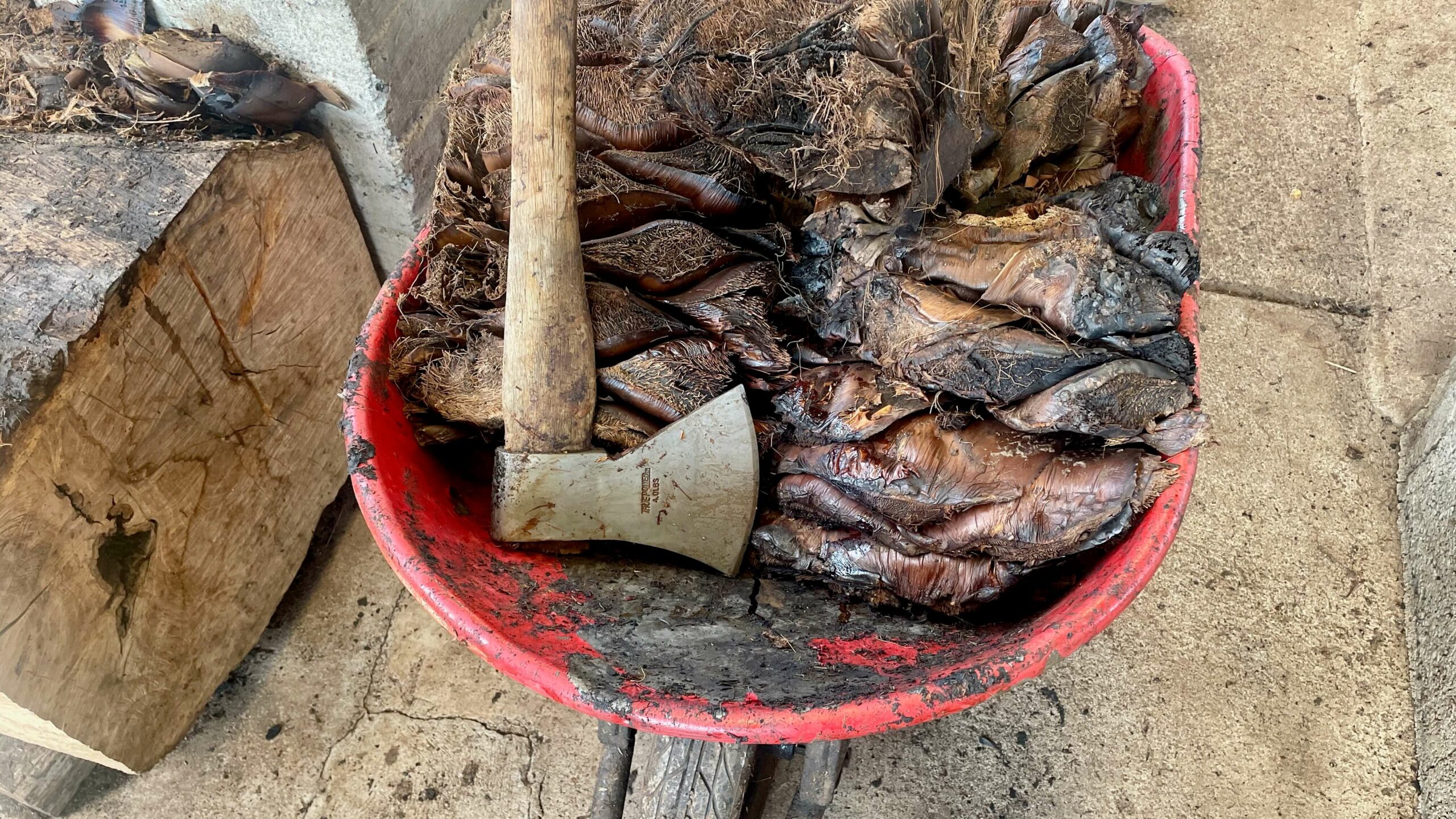
Cooked agave ready to be mashed and fermented
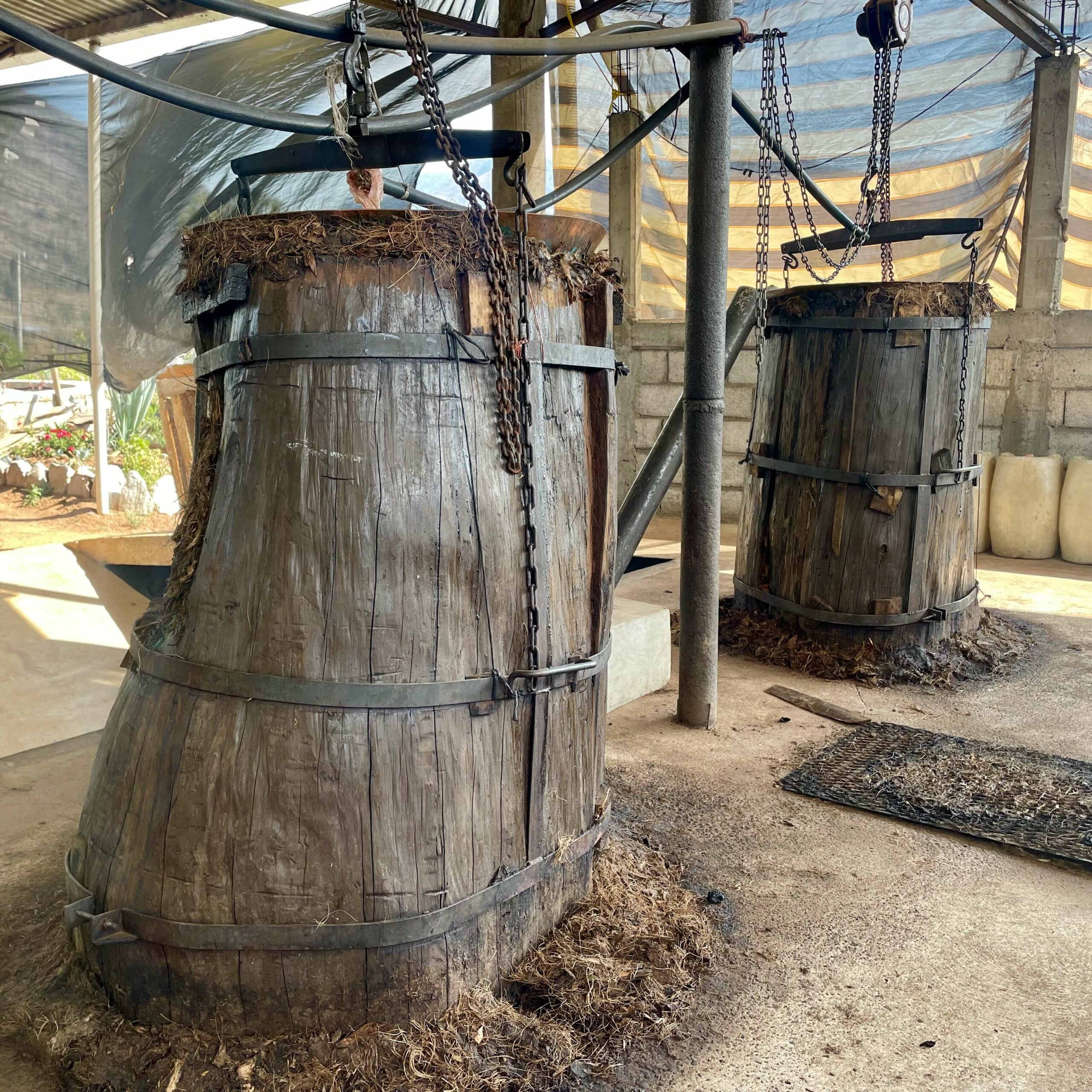
Salto Bonito has a pulley system to remove the still tops when loading and unloading mash
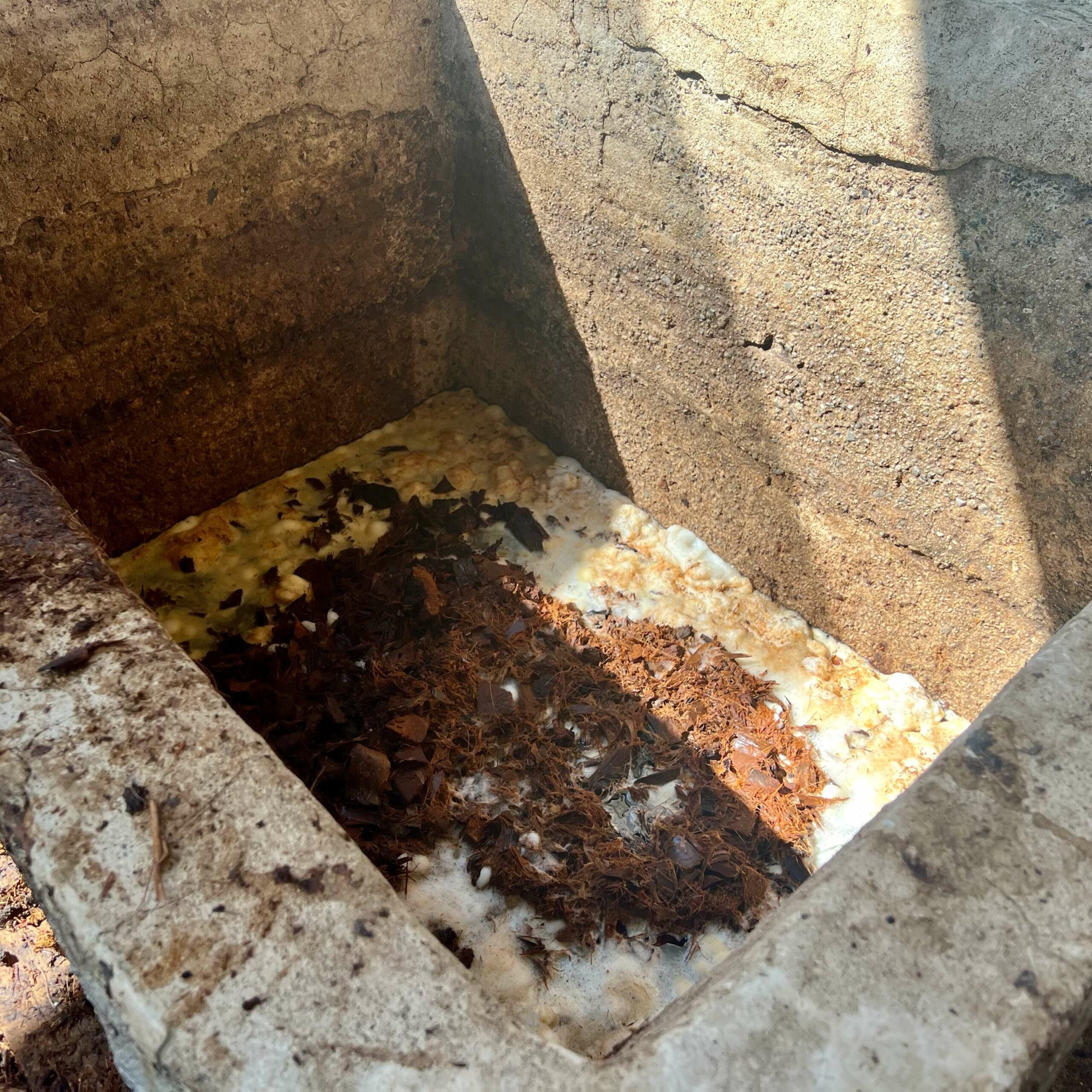
Mashed agave fermenting in a deep cement tank
Miguel and Jorge operate in their own world where mezcal tradition meets innovation. Jorge, a fourth-generation maestro, experiments with unconventional flavors and techniques. Miguel, the fifth generation, is eager to expand on that foundation. While Miguel uses a tool to measure the brix content of the agaves, Jorge uses only his senses. That day, they had a triple distilled Alto with fresh oranges added in the final distillation. The dryness of the Alto balanced perfectly with the citric juiciness of the oranges.
Jorge stood back, observing, as we sipped the delicious mezcal. We later agreed that Jorge had a John Wayne vibe about him. It wasn’t just his large hat and stature. But his humble yet large presence. He was quiet and you could tell he was listening intently. His years of mining and producing mezcal in rural Michoacán had given him a level of grit; you could see it in his eyes. Miguel proudly told us his father had taught 20 other producers in the area how to craft quality mezcal.
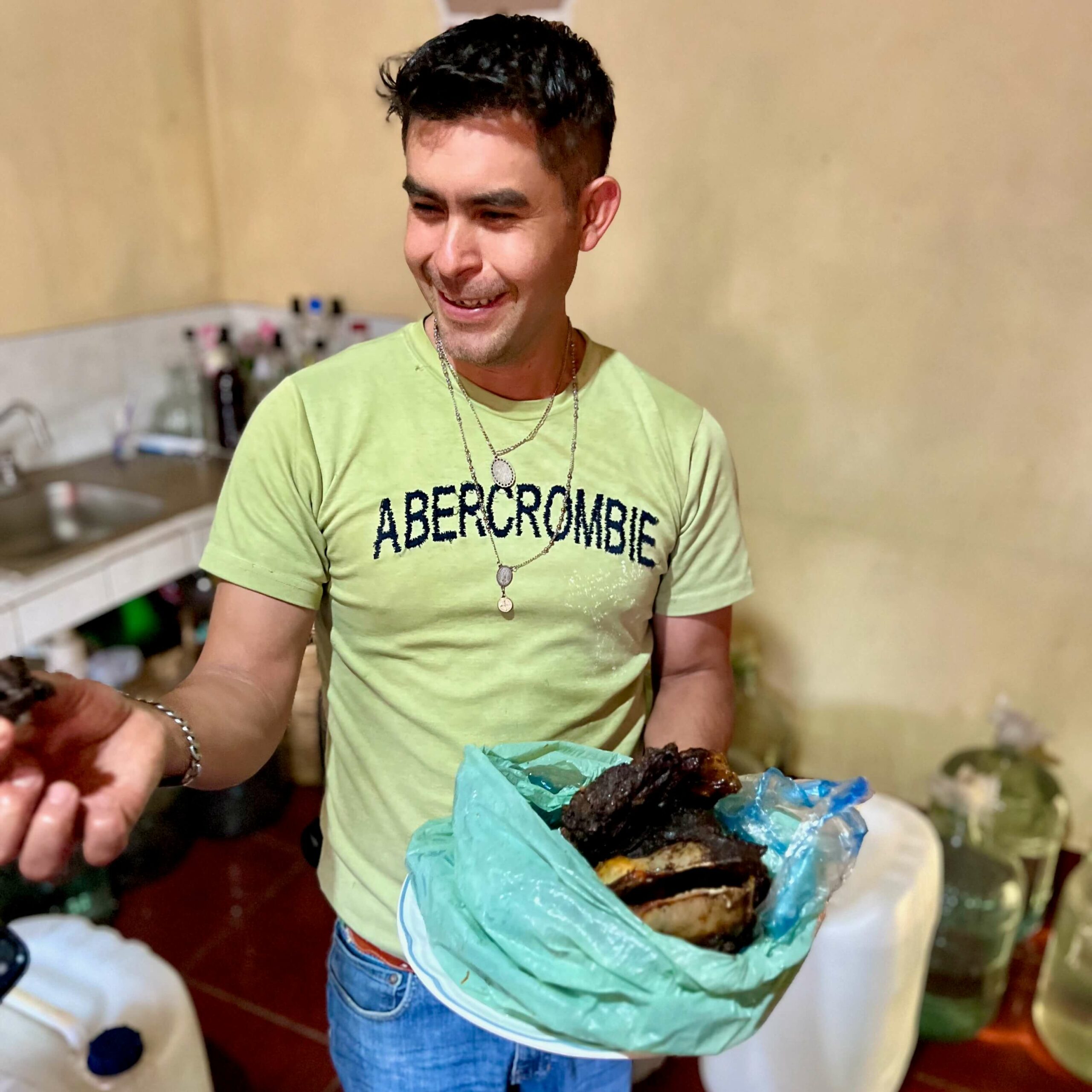
Miguel offering some coyote meat to the adventurous ones in our group
That day, we tasted one of the most bizarre mezcals to date: an abocado con coyote. Yes, the animal was placed into distilled mezcal. We couldn’t believe it as we sipped it.. wondering if we translated the words in our heads correctly. Miguel saw our surprised reactions, laughing, and patting us on the back excitedly.
We looked at Alva, double-checking our understanding of the situation. She laughed. Miguel ran off and quickly returned with a tin foil wrapper. He folded back some foil, “coyote”. This was unexpected.. We ate small pieces of the coyote, presumably cooked at that point.
Dinner with Isidro Rodriguez
Hours had passed since we began our mezcal tour. The sun began to lower in the sky, late in the day. Alva asked if we still wanted to go to our last stop.. Of course! She seemed surprised by our ability to consume distilled agave. This wasn’t our first rodeo.
We were having a wonderful time with Miguel, Jorge, and their family, but it was time to move on.
It was time to visit one of Jorge’s most well-known students: Isidro Rodriguez.
Just down the road from the Perez home and vinata was Isidro’s house. His own vinata was further away and at this point in the day, we planned to visit Isidro for dinner. Isidro’s October 2019 batch of Alto from Mal Bien became a gateway mezcal to the world beyond Oaxaca. It was also the first time his mezcal had been exported commercially. This highly rated mezcal has reviews which include words like “different” and “unique”. Given the vast majority of mezcal was from Oaxaca – agave fans were primed for new unique flavors.
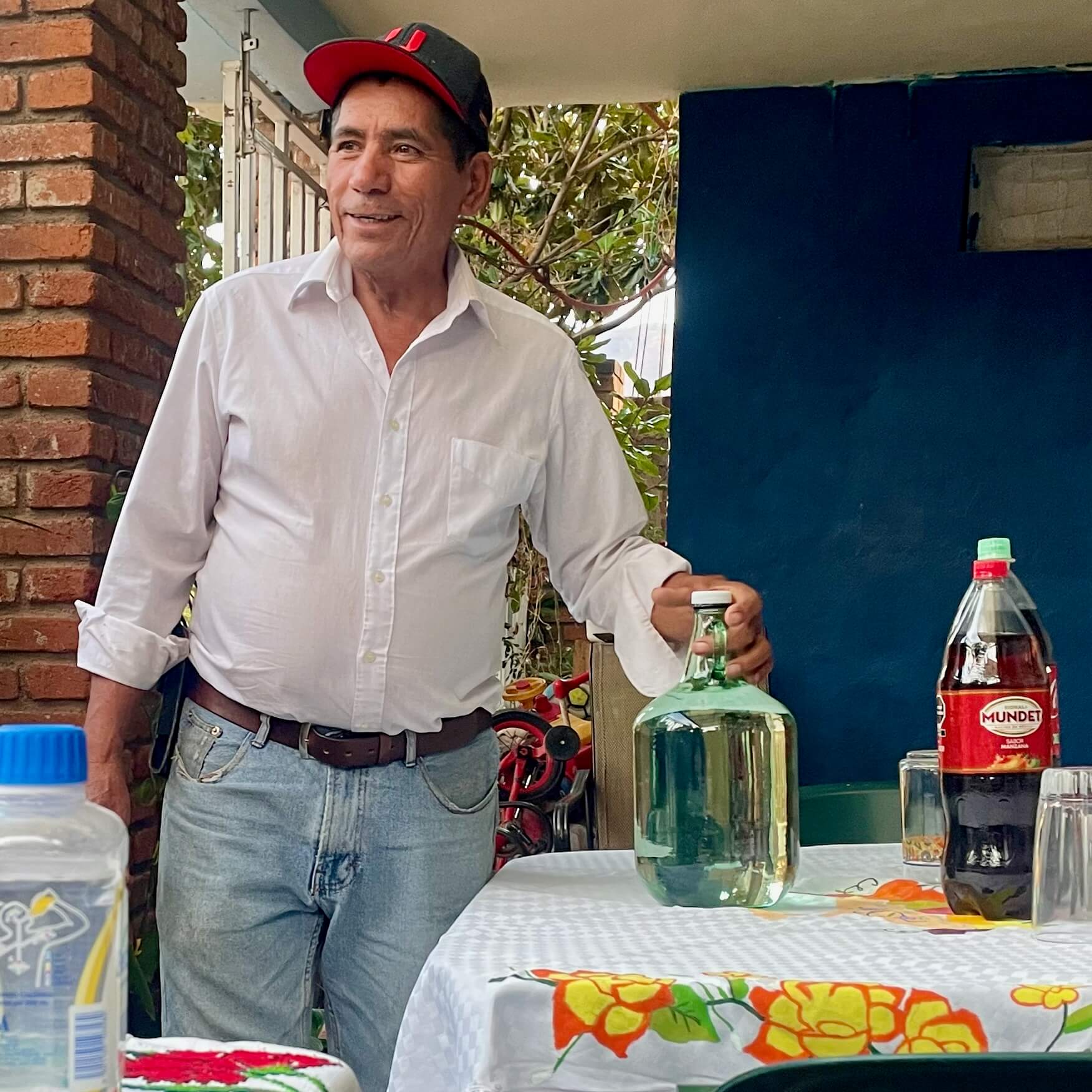
Isidro Rodriguez holds some of his delicious mezcal
Isidro greeted us upon arrival with a warm smile. His deep voice reminded us of a baseball announcer. As a first generation mezcalero, Isidro trained under Jorge. He began making mezcal at the age of 19, using the community vinata for many years before establishing his own. Now he rents out his own distillery every so often, helping the new community as they helped him in the past. His sons also help in his vinata, becoming the second generation of producers in his family.
That evening he had a unique pechuga on hand, one made with a few meats along with trout. The team at Mal Bien described it well when discussing their first visit with Isidro: “He had two batches on hand, an alto and an alto pechuga made with trout from nearby Lake Cuitzeo. Both were incredibly good, and unlike anything we’d tasted before. The alto was super clean, light, and mineral-driven with a touch of fruit, and the fish pechuga was surprisingly more delicious and less weird than expected.”
A small town with big flavors
It was a pleasure spending time with Isidro after being a fan of his Alto for so many years. While his process is nearly identical to his teacher, Jorge Perez, many factors can lead to slightly different flavors. While some of the flavors of pulque and Maguey Alto had similar notes, the mezcalero town of Río de Parras offered an opportunity to try similar mezcals made hundreds of yards from each other yet with different flavors.
We cannot wait to return to Río de Parras. The town has a community plaza built with the support of the non-profit SACRED (Saving Agave for Culture, Recreation, Education and Development) and a mezcaleria and restaurant. In future visits, we’d like to visit Jorge’s neighbor Raul Pedraza Padilla and also María Pérez – one of the first Michoacán mezcals we ever tried under the Almamezcalera label. Who knows what the next generation will bring to the mezcalero town of Michoacán.


